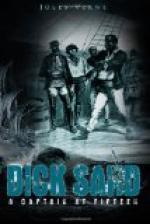To have on the end of his nose a tuberculous manticore, with large elytrums—an insect of the cicendeletes tribe—a very rare specimen in collections—one that seems peculiar to those southern parts of Africa, and yet not utter a cry of admiration; that is beyond human strength.
Unfortunately the manticore heard this cry, which was almost immediately followed by a sneeze, that shook the appendage on which it rested. Cousin Benedict wished to take possession of it, extended his hand, shut it violently, and only succeeded in seizing the end of his own nose.
“Malediction!” exclaimed he. But then he showed a remarkable coolness.
He knew that the tuberculous manticore only flutters about, so to say, that it walks rather than flies. He then knelt, and succeeded in perceiving, at less than ten inches from his eyes, the black point that was gliding rapidly in a ray of light.
Evidently it was better to study it in this independent attitude. Only he must not lose sight of it.
“To seize the manticore would be to risk crushing it,” Cousin Benedict said to himself. “No; I shall follow it! I shall admire it! I have time enough to take it!”
Was Cousin Benedict wrong? However that may be, see him now on all fours, his nose to the ground like a dog that smells a scent, and following seven or eight inches behind the superb hexapode. One moment after he was outside his hut, under the midday sun, and a few minutes later at the foot of the palisade that shut in Alvez’s establishment.
At this place was the manticore going to clear the enclosure with a bound, and put a wall between its adorer and itself? No, that was not in its nature, and Cousin Benedict knew it well. So he was always there, crawling like a snake, too far off to recognize the insect entomologically—besides, that was done—but near enough to perceive that large, moving point traveling over the ground.
The manticore, arrived near the palisade, had met the large entrance of a mole-hill that opened at the foot of the enclosure. There, without hesitating, it entered this subterranean gallery, for it is in the habit of seeking those obscure passages. Cousin Benedict believed that he was going to lose sight of it. But, to his great surprise, the passage was at least two feet high, and the mole-hill formed a gallery where his long, thin body could enter. Besides, he put the ardor of a ferret into his pursuit, and did not even perceive that in “earthing” himself thus, he was passing outside the palisade.
In fact, the mole-hill established a natural communication between the inside and the outside. In half a minute Cousin Benedict was outside of the factory. That did not trouble him. He was absorbed in admiration of the elegant insect that was leading him on. But the latter, doubtless, had enough of this long walk. Its elytrums turned aside, its wings spread out. Cousin Benedict felt the danger, and, with his curved hand, he was going to make a provisional prison for the manticore, when—f-r-r-r-r!—it flew away!




